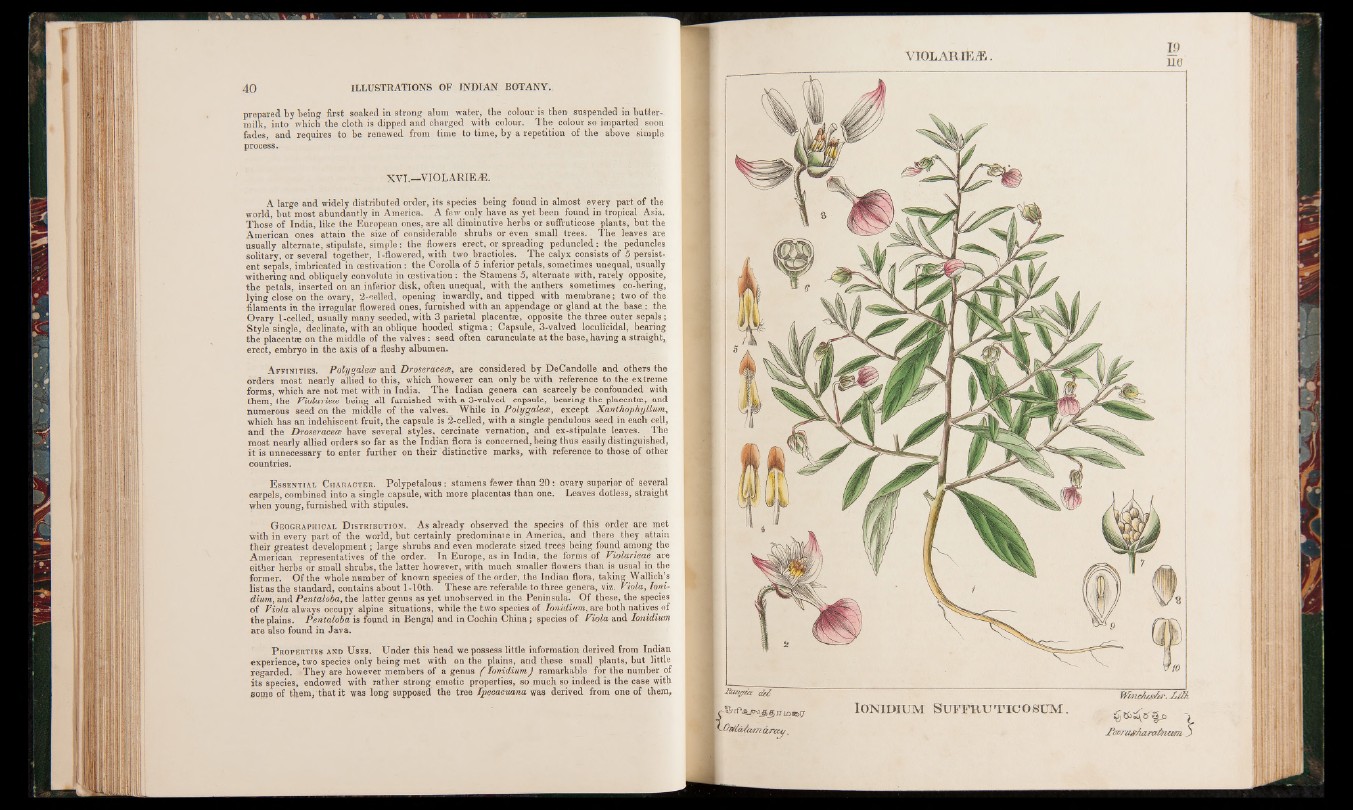
prepared by being first soaked in strong alum water, the colour is then suspended in buttermilk,
into which the cloth is dipped and charged with colour. The colour so imparted soon
fades, and requires to be renewed from time to time, by a repetition of the above simple
process.
XYI.—VIOLARIEA3.
A large and widely distributed order, its species being found in almost every part of the
world, but most abundantly in America. A few only have as yet been found in tropical Asia.
Those of India, like the European ones, are all diminutive herbs or suffruticose plants, but the
American ones attain the size of considerable shrubs or even small trees. The leaves are
usually alternate, stipulate, simple: the flowers erect, or spreading peduncled: the peduncles
solitary, or several together, 1 -flowered, with two bractioles. The calyx consists of 5 persistent
sepals, imbricated in aestivation: the Corolla of 5 inferior petals, sometimes unequal, usually
withering and obliquely convolute in aestivation : the Stamens 5, alternate with, rarely opposite,
the petals, inserted on an inferior disk, often unequal, with the anthers sometimes co-hering,
lying close on the ovary, 2-oelled, opening inwardly, and tipped with membrane; two of the
filaments in the irregular flowered ones, furnished with an appendage or gland at the base: the
Ovary 1-celled, usually many seeded, with 3 parietal placentae, opposite the three outer sepals;
Style single, declinate, with an oblique hooded stigma: Capsule, 3-valved loculicidal, bearing
the placentae on the middle of the valves : seed often carunculate at the base, having a straight,,
erect, embryo in the axis of a fleshy albumen.
A ffinities. Polyoalece and Droseracea, are considered by DeCandolle and others the
orders most nearly allied to this, which however can only be with reference to the extreme
forms, which are not met with in India. The Indian genera can scarcely be confounded with
them, the Violariece being all furnished with a 3-valved capsule, bearing the placentae, and
numerous seed on the middle of the valves. While in Polygalece, except Xanthophyllum,
which has an indehiscent fruit, the capsule is 2-celled, with a single pendulous seed in each cell,
and the Droseracece have several styles, cercinate vernation, and ex-stipulate leaves. The
most nearly allied orders so far as the Indian flora is concerned, being thus easily distinguished,
it is unnecessary to enter further on their distinctive marks, with reference to those of other
countries.
E ssential C haracter. Polypetalous: stamens fewer than 20: ovary superior of several
carpels, combined into a single capsule, with more placentas than one. Leaves dotless, straight
when young, furnished with stipules.
G eographical D istribution. A s already observed the species of this order are met
with in every part of the world, but certainly predominate in America, and there they attain
their greatest development; large shrubs and even moderate sized trees being found among the
American representatives of the order. In Europe, as in India, the forms of Violarieae are
either herbs or small shrubs, the latter however, with much smaller flowers than is usual in the
former. Of the whole number of known species of the order, the Indian flora, taking Walfich’s
list as the standard, contains about l-10th. These are referable to three genera, viz. Viola, Iqni-
dium, and Pentaloba, the latter genus as yet unobserved in the Peninsula. Of these, the species
of Viola always occupy alpine situations, while the two species of Ionidium, are both natives of
the plains. Pentaloba is fopnd in Bengal and in Cochiq China; species of Viola and Ionidium
are also found in Java.
P roperties and U ses. Under this head we possess little information derived from Indian
experience, two species only being met with on the plains, and these small plants, but little
regarded. They are however members of a genus f Ionidium) remarkable for the number of
its species, endowed with rather strong emetic properties, so much so indeed is the case with
jsojpe pf them, that it was long supposed the tree Ipecacuana was derived from one of them,
VIOLARIEÆ
Io n id ium Su f f b u t ic o s u m .